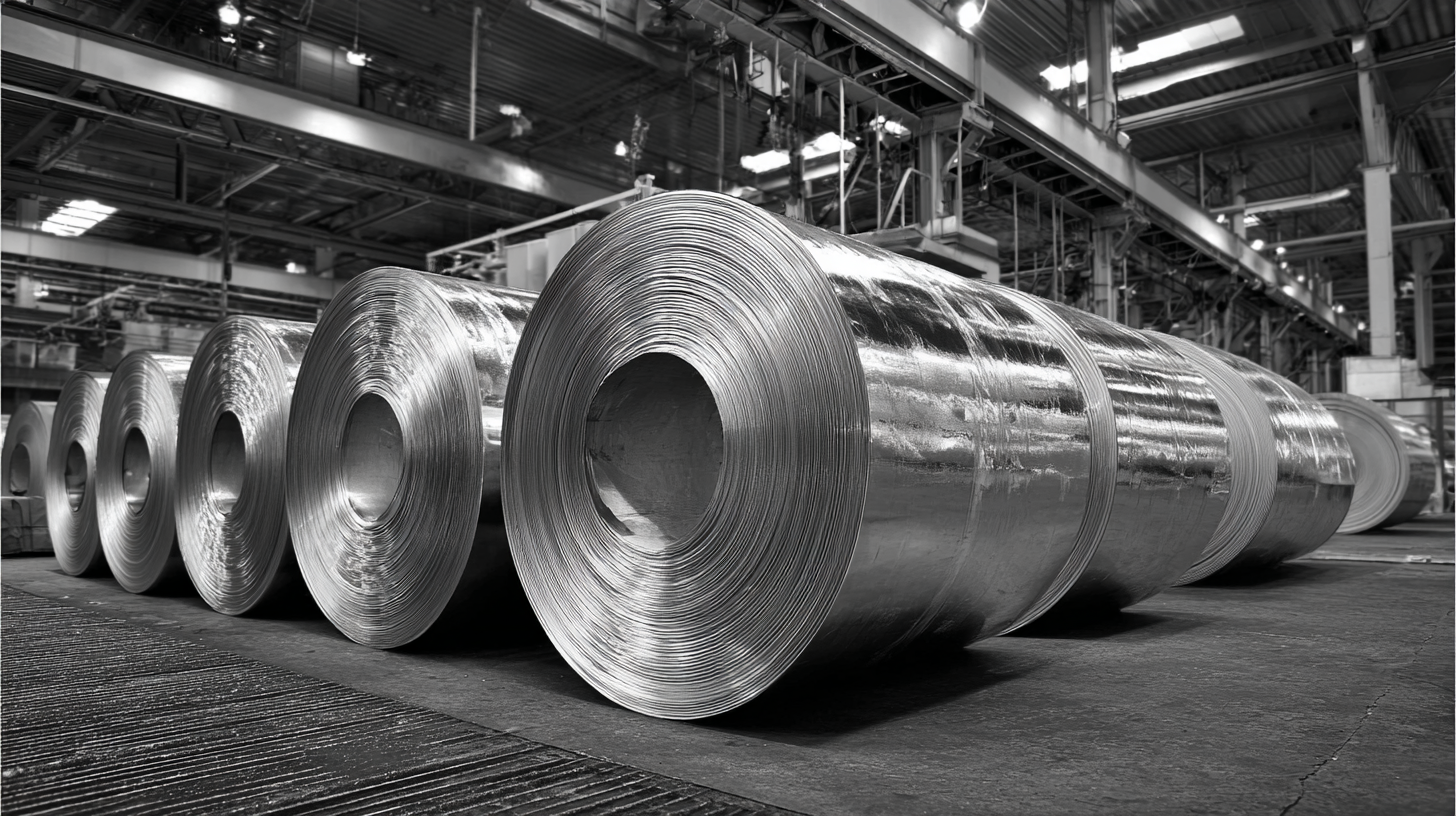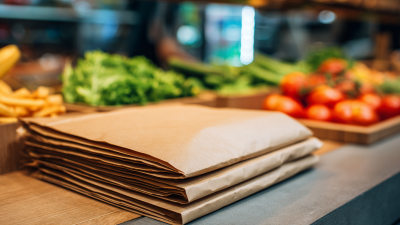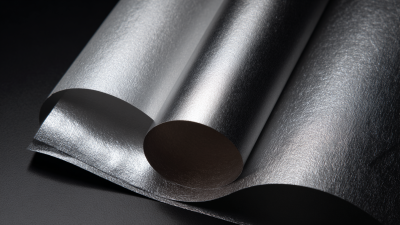2025 Top 10 Industrial Aluminum Foil Products You Need to Know
As the demand for lightweight, durable, and versatile materials continues to rise across various industries, the significance of industrial aluminum foil has come to the forefront. According to a report by Global Market Insights, the industrial aluminum foil market is projected to exceed USD 10 billion by 2025, driven by its applications in packaging, automotive, and aerospace sectors. This growth is attributed to the material's unique properties such as corrosion resistance, thermal conductivity, and barrier protection, which make it an essential component in many industrial applications.

Industry expert Dr. Susan Whitmore, a leading authority on aluminum manufacturing technologies, states, "The innovations in industrial aluminum foil production have opened new avenues for sustainable packaging solutions, reflecting the industry's shift towards eco-friendly practices." With advancements in processing techniques and an increasing focus on recyclability, industrial aluminum foil is poised to revolutionize how products are packaged and protected.
In this article, we will explore the top 10 industrial aluminum foil products that are set to make waves in 2025. Highlighting their functionalities and market potentials will provide valuable insights for businesses looking to leverage these cutting-edge materials in their operations.
Emerging Trends in Industrial Aluminum Foil Products for 2025
As we look towards 2025, the industrial aluminum foil market is poised for significant transformations, shaped by emerging trends that reflect environmental, technological, and consumer preferences. According to a recent market study by Global Market Insights, the industrial aluminum foil market is projected to reach approximately $18 billion by 2025, driven by increasing demand across various sectors, including packaging, automotive, and electronics.
One of the most notable trends is the rise in sustainable packaging solutions. With manufacturers seeking to reduce their carbon footprints, there is a growing emphasis on lightweight and recyclable aluminum foil. Reports indicate that nearly 70% of the aluminum foil produced is now being sourced from recycled materials, which not only conserves energy but also reduces waste. This shift aligns with global sustainability goals and is expected to enhance the demand for aluminum foil products designed with eco-friendly attributes.
Additionally, advancements in technology are paving the way for innovative foil applications. The development of thinner, more durable aluminum foils has become a game-changer in the food packaging sector, promising longer shelf lives and better barrier properties against moisture and oxygen. Industry forecasts suggest that these innovations will help generate a compound annual growth rate (CAGR) of over 5% within the industrial aluminum foil segment through 2025, reflecting an evolving marketplace responsive to both technological enhancements and sustainability imperatives.
Key Applications of Aluminum Foils in Various Industries
Aluminum foil is becoming increasingly essential across various industries due to its unique properties and applications. In the electronics sector, aluminum foil is a critical raw material for electrolytic capacitors, which are crucial components in devices ranging from smartphones to electric vehicles. According to industry reports, the market for electronic aluminum foil is rapidly expanding, with significant players driving advancements in production technology. For instance, the integration of laser technology in manufacturing has been recognized as a method to enhance the efficiency and precision of aluminum components, particularly in the burgeoning lithium battery market for electric vehicles.
In addition to electronics, the food packaging industry heavily relies on aluminum foil for its excellent barrier properties, helping to preserve freshness while also ensuring safety and hygiene. The lightweight and recyclable nature of aluminum foil makes it a preferred choice in packaging applications. Recent studies indicate that the global aluminum foil market is on track to reach significant revenue milestones, reflecting an increased demand spurred by innovations in packaging designs and the growing trend of sustainable materials. This multifaceted role of aluminum foil across different industrial applications underscores its importance and the ongoing advancements that continue to shape its future.
2025 Top 10 Industrial Aluminum Foil Products You Need to Know
| Product Type | Key Applications | Thickness (microns) | Industry Usage |
|---|---|---|---|
| Food Packaging Foil | Ready-to-eat meals, snack packaging | 9 - 30 | Food Industry |
| Pharmaceutical Foil | Blister packs, pouches | 20 - 50 | Pharmaceuticals |
| Insulation Foil | Building insulation, HVAC | 100 - 200 | Construction |
| Electromagnetic Foil | Shielding for electronics | 5 - 15 | Electronics |
| Heat Seal Foil | Sealing food packages | 15 - 30 | Food Industry |
| Reflective Insulation Foil | Energy-efficient buildings | 200 - 300 | Construction |
| Industrial Packaging Foil | Heavy-duty shipping containers | 50 - 120 | Logistics |
| Battery Foil | Li-ion battery production | 15 - 20 | Energy |
| Electrical Foil | Transformers, capacitors | 10 - 50 | Electrical Engineering |
| Composite Foil | Medical packaging, structural components | 25 - 60 | Medical, Aerospace |
Innovative Technologies Driving Aluminum Foil Production
The aluminum foil industry is witnessing a significant transformation driven by innovative technologies aimed at enhancing production efficiency and sustainability. As highlighted in the recent Global Market Analysis Report, the Aluminum Foil Peel-Off Ends Maker Market is anticipated to reach USD 453.1 million by 2035, showcasing a robust compound annual growth rate (CAGR) of 4.2% from 2025. This growth signifies not only an increase in demand but also the potential for advancements in manufacturing processes that leverage automation and IoT technologies.
Moreover, innovations like coreless aluminum foil roll technology are revolutionizing production by minimizing waste and improving environmental impacts. These advancements align with global trends towards sustainability, reflecting a broader industry shift where eco-friendly practices are becoming the norm. For example, a recent study from Oman outlines a novel approach that effectively combats bacterial and fungal contamination using environmentally sustainable methods, indicating a growing trend in developing products that prioritize health and safety without compromising on functionality.
2025 Top 10 Industrial Aluminum Foil Products You Need to Know
This bar chart illustrates the projected market growth rates for the top 10 industrial aluminum foil product categories in 2025. The data highlights the varying levels of demand and innovation across different sectors, showcasing the versatility and essential role of aluminum foil in modern industry.
Environmental Impact and Sustainability of Aluminum Foil Products
The environmental impact and sustainability of aluminum foil products are increasingly important considerations as industries and consumers alike shift towards more eco-conscious practices. According to a report by the Aluminum Association, recycling rates for aluminum foil in the U.S. are estimated to be around 50%. Recycling aluminum saves more than 90% of the energy needed to produce new aluminum from raw materials, which significantly reduces greenhouse gas emissions. This energy efficiency presents a compelling argument for adopting aluminum foil products, especially in a climate-conscious market.
Further emphasizing sustainability, the lifecycle analysis of aluminum foil shows that while the production process is energy-intensive, the material's durability and recyclability contribute to its overall environmental benefits. The European Aluminium Foil Association reports that nearly 40% of all aluminum foil is produced from recycled aluminum. By choosing aluminum foil products, consumers not only benefit from their practicality but also support a circular economy that minimizes waste and conserves resources. As we move into 2025, innovations in production processes and increased recycling initiatives will likely enhance the sustainability profile of aluminum foil products even further.

Top Manufacturers and Market Leaders in Aluminum Foil Industry 2025
The aluminum foil industry is experiencing significant growth, driven by the expansion of its applications across various sectors. By 2025, the aluminum foil packaging market is projected to reach a substantial value, with an increasing focus on sustainable packaging solutions. Market leaders are innovating in materials and processes to enhance the functionality and environmental impact of their products, catering to the rising demand for eco-friendly options from consumers and regulatory bodies alike.

Several key manufacturers in the aluminum foil segment are poised to dominate the market landscape. Their investments in advanced technologies and automated production lines are helping to improve product quality and reduce costs. Companies are also exploring strategic partnerships and collaborations to expand their reach in emerging markets, while adapting to changing consumer preferences. As the industry evolves, the presence of these top manufacturers will shape the future of aluminum foil products, ensuring they remain a vital component in various applications, including packaging and electrical insulation.
Related Posts
-

How to Effectively Use Aluminium Foil in Your Kitchen for Optimal Cooking Results
-

5 Tips for Maxing Out the Benefits of Alu Foil in Your Kitchen
-

The Environmental Impact of Food Paper Products on Sustainable Packaging Solutions
-

The Surprising Science of Tin Foil: Uncovering Its Hidden Uses in Everyday Life
-

Ultimate Guide to Creative Uses of Tin Foil in Everyday Life
-

Exploring Silver Foil Paper Trends and Market Dynamics at the 138th Canton Fair 2025 in China
